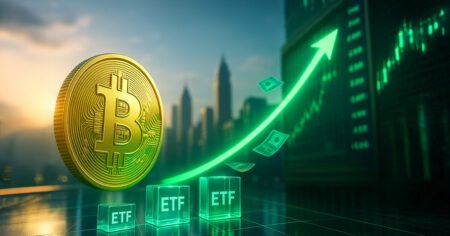The High-Stakes Game of Leveraged Cryptocurrency ETFs: What You Need to Know
On October 14, the SEC received significant filings that have the potential to shake up the cryptocurrency market. Volatility Shares, known for launching the first leveraged Bitcoin ETF, is seeking to introduce a suite of 5x funds linked to major cryptocurrencies like Bitcoin, Ethereum, Solana, and XRP. If approved, these ETFs would magnify daily returns by a factor of five, resulting in a double-edged sword that both amplifies gains and compounds losses.
The Mechanics of 5x ETFs
The proposed 5x funds, named 5x BTC, 5x ETH, 5x SOL, and 5x XRP, are designed to track futures contracts, not the actual cryptocurrencies. This is pivotal because it means the funds will rebalance daily, resetting their exposure to five times the single-day movement of their respective assets. For example, if Bitcoin rises by 2%, the ETF aims to rise by 10%. Conversely, if Bitcoin declines by 2%, the ETF drops by 10%. Such a model introduces what is called "volatility decay," a phenomenon where compounding losses can diminish returns significantly if investors hold them over longer periods.
Inside the 5x Investment Structure
Volatility Shares’ strategy revolves around daily resets using derivatives within a wholly owned subsidiary in the Cayman Islands. Each ETF employs swaps, exchange-traded futures, and various options to achieve its target returns, all while maintaining high-quality collateral to mitigate risks. However, daily readjustments can lead to persistent tracking errors, and in volatile market conditions, these errors can accumulate and result in substantial losses.
In practice, these ETFs are not designed for long-term investment but are better suited for frequent trading or scalping. The math behind these funds becomes particularly precarious during choppy market conditions, where a single negative session can wipe out weeks of gains. The anticipated performance is often compromised when investors hold beyond a single trading day, leading to underperformance compared to the underlying asset’s index.
Risks and Volatility: The Bear Trap for Investors
Traders looking for quick profits should approach these leveraged ETFs with caution. The daily resets and the associated costs create a precarious situation, especially when underlying assets experience rapid shifts in price. For instance, a 5x Bitcoin ETF could involve significant futures collateral maintenance, with borrowing costs and volatility spreads cutting into potential returns during turbulent periods. Research indicates that when the daily volatility exceeds 2%, the performance gap becomes increasingly severe.
For example, recent price swings in cryptocurrencies like Solana—exceeding 15% within a week—could lead a 5x fund to perform disastrously, potentially losing most of its theoretical gains in the process. Therefore, the costs and risks related to these funds cannot be overstated, making them ill-suited for investors who don’t frequently monitor their positions.
Trading Versatility vs. Conventional Investment Strategies
The rise of leveraged ETFs represents a fascinating intersection of traditional finance and the burgeoning world of cryptocurrencies. While these funds offer traders the prospect of amplified returns, they also create a unique risk profile. Retail traders can now access crypto exposure through structured products that don’t require margin accounts, allowing them to speculate on volatility more conveniently.
Nevertheless, the eagerness to exploit these financial instruments could lead to rapid wealth transfer from inexperienced or impatient traders to market makers. The SEC’s role in scrutinizing these filings is crucial, particularly given that the leveraged ETFs rely on a stable and deep futures market for efficient functioning. Any disruptions in open interest or liquidity could lead these funds to experience substantial losses, compounding the risks further.
The SEC’s Scrutiny and the Future of 5x Funds
The SEC’s careful evaluation of Volatility Shares’ filings highlights the regulatory challenges surrounding these investment products. The issuer’s reliance on futures contracts means that there is no direct custody of cryptocurrencies, which limits certain operational risks while introducing others related to liquidity and funding. When dealing with volatile and speculative investments, regulatory oversight becomes paramount to protect investors.
If approved, the introduction of these 5x funds could create a self-reinforcing cycle in the cryptocurrency market, amplifying volatility and potentially deepening liquidations. This outcome reflects a broader trend in which traditional financial engineering increasingly permeates the cryptocurrency landscape.
Conclusion: Proceed with Caution
As the cryptocurrency market evolves, so too does the complexity of its financial instruments. While Volatility Shares’ proposed 5x ETFs may attract traders eager for leveraged exposure, the associated risks cannot be ignored. These funds serve more as timing tools than long-term investments, making them suitable only for those willing to actively manage their portfolios and scrutinize market conditions closely.
The allure of substantial gains comes hand-in-hand with the risk of swift losses, making it essential for traders to weigh their appetite for volatility against the need for due diligence. In essence, only traders with ironclad attention spans and a keen sense of timing should consider these high-stakes financial products.

















